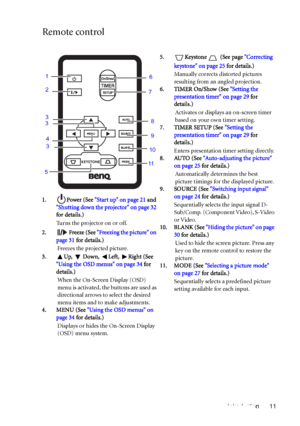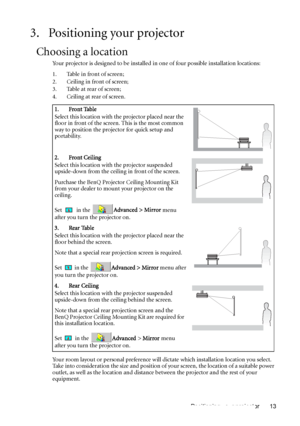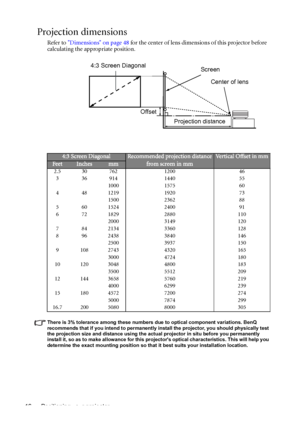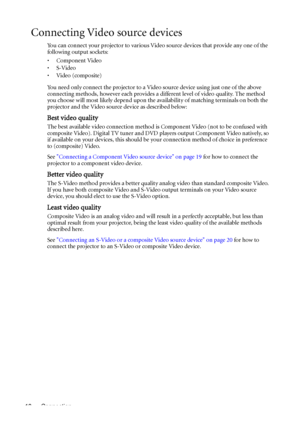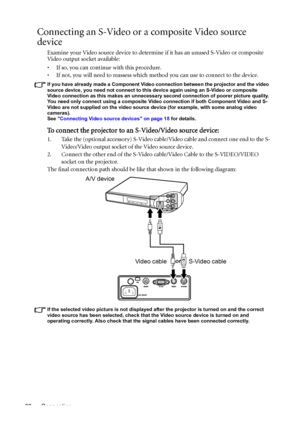BenQ Mp510 Dlp Users Manual
Here you can view all the pages of manual BenQ Mp510 Dlp Users Manual. The BenQ manuals for Projector are available online for free. You can easily download all the documents as PDF.
Page 11
Introduction 11 Remote control 1. Power (See Start up on page 21 and Shutting down the projector on page 32 for details.) Turns the projector on or off. 2. Freeze (See Freezing the picture on page 31 for details.) Freezes the projected picture. 3. Up, Down, Left, Right (See Using the OSD menus on page 34 for details.) When the On-Screen Display (OSD) menu is activated, the buttons are used as directional arrows to select the desired menu items and to make adjustments. 4. MENU (See Using the OSD...
Page 12
Introduction 12 Remote control effective range Infra-Red (IR) remote control sensors are located on the front and the back of the projector. The remote control must be held at an angle within 30 degrees perpendicular to the projectors IR remote control sensors to function correctly. The distance between the remote control and the sensors should not exceed 6 meters (~ 20 feet). Make sure that there are no obstacles between the remote control and the IR sensors on the projector that might obstruct the...
Page 13
Positioning your projector 13 3. Positioning your projector Choosing a location Your projector is designed to be installed in one of four possible installation locations: 1. Table in front of screen; 2. Ceiling in front of screen; 3. Table at rear of screen; 4. Ceiling at rear of screen. Your room layout or personal preference will dictate which installation location you select. Take into consideration the size and position of your screen, the location of a suitable power outlet, as well as the...
Page 14
Positioning your projector 14 Obtaining a preferred projected picture size The distance from the projector lens to the screen, and the video format each factors in the projected picture size. The native resolution of the projector is 800 x 600 pixels, which is a 4 to 3 aspect ratio (expressed as 4:3). To be able to project a complete 16:9 (widescreen) aspect ratio picture, the projector can resize and scale a widescreen picture to the projectors native aspect width. This will result in a...
Page 15
Positioning your projector 15 horizontal distance from the center of the screen (projection distance), and the vertical offset height of the projector from the horizontal edge of the screen (offset). How to determine the position of the projector for a given screen size 1. Select your screen size. 2. Refer to the table and find the closest match to your screen size in the left columns labelled 4:3 Screen Diagonal. Using this value, look across this row to the right to find the corresponding average...
Page 16
Positioning your projector 16 Projection dimensions Refer to Dimensions on page 48 for the center of lens dimensions of this projector before calculating the appropriate position. There is 3% tolerance among these numbers due to optical component variations. BenQ recommends that if you intend to permanently install the projector, you should physically test the projection size and distance using the actual projector in situ before you permanently install it, so as to make allowance for this projectors...
Page 17
Connection 17 4. Connection When connecting a signal source to the projector, be sure to: 1. Turn all equipment off before making any connections. 2. Use the correct signal cables for each source. 3. Ensure the cables are firmly inserted. In the connections shown below, some cables may not be included with the projector (see Shipping contents on page 8). They are commercially available from electronics stores. Connecting a computer The projector provides a VGA input socket that allows you to connect it...
Page 18
Connection 18 Connecting Video source devices You can connect your projector to various Video source devices that provide any one of the following output sockets: • Component Video •S-Video •Video (composite) You need only connect the projector to a Video source device using just one of the above connecting methods, however each provides a different level of video quality. The method you choose will most likely depend upon the availability of matching terminals on both the projector and the Video...
Page 19
Connection 19 Connecting a Component Video source device Examine your Video source device to determine if it has a set of unused Component Video output sockets available: • If so, you can continue with this procedure. • If not, you will need to reassess which method you can use to connect to the device. To connect the projector to a Component Video source device: 1. Take the (optional accessory) Component Video to VGA (D-Sub) adaptor cable and connect the end with 3 RCA type connectors to the...
Page 20
Connection 20 Connecting an S-Video or a composite Video source device Examine your Video source device to determine if it has an unused S-Video or composite Video output socket available: • If so, you can continue with this procedure. • If not, you will need to reassess which method you can use to connect to the device. If you have already made a Component Video connection between the projector and the video source device, you need not connect to this device again using an S-Video or composite...
